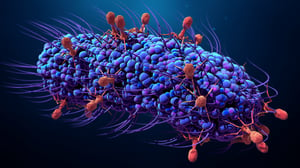TrustBix blog: The Future of Feed Additives

In this blog, we are looking at two vital components of feed additives–bacteriophages and performance trace minerals
TrustBix
Many people claim that antibiotics are the greatest invention of the 20th century. Indeed, it is hard to argue this statement because they changed the way we live today. However, the 21st century started with a wave of antibiotics-related restrictions and limitations all over the world.
Namibia, for example, was the first African country to completely ban the regular use of antibiotics in the beef sector thirty years ago.
“Feed additives for livestock are like supplements and vitamins for people: constantly developing to help us live a healthier life”
Today, using antibiotics as growth promoters or disease treatments in livestock is prohibited in numerous countries worldwide because the problem of antibiotic resistance is disturbing. That is why the global agri-food and scientific communities are looking into the use of bacteriophages to overcome this challenge in the livestock industry.
Bacteria “Eaters” for the Agrifood Sector
Bacteriophages, also known as phages, are the most common natural entities that have been used even before antibiotics were discovered. In simple terms, they are viruses that selectively target and kill multi-drug-resistant bacteria. Without going into too much detail regarding how phages work, let’s examine why they are vital for the global agri-food industry. Here are the three main advantages:
- They only attack specific bacteria without affecting other organisms.
- They can survive in several environments, for example, water, soil, and food.
- Since they are abundant in nature, it takes less time to develop new bacteriophages than a conventional antibiotic.
However, as with anything in this world, there are certain drawbacks:
- Some people might be reluctant to accept the use of phages because they are, by nature, viruses, and viruses are dangerous. Indeed, phages are dangerous, but only to the specific bacteria they attack. They are totally harmless to plants, animals, people, and the environment.
- A detailed study into a phage’s biology and genetic characteristics is required to ensure the best use possible.
- It is often necessary to use a mixture of phages because they are so specific to make sure that all bacteria strains are eliminated and to minimize the probability of acquiring resistance.
Here, at TrustBIX, we agree with the global community that the advantages outweigh the disadvantages. That is why we trust professionals. We are proud to be a partner of Arden Biotechnology, the company that focuses on alleviating problems induced by the removal of antimicrobials from the food chain.
Their most recent development, “Sustavian,” is an antibiotic replacement technology for poultry. Basically, it is a bacteriophage cocktail that improves the feed conversion ratio and fights necrotic enteritis, for example. In addition, it is going to help producers meet the growing demand for verified antibiotic-free meat products in the coming years. It can also enhance the sustainability of poultry farming by supporting the transition of agriculture to a NetZero emission industry. You can read more about “Sustavian” and TrustBIX’s role here.
Prevention is the Best Action
Another way to improve the overall wellbeing of animals, help improve reproductive performance and growth, and battle numerous diseases is performance trace minerals. We have mentioned them in our previous blog, but today we would like to highlight that while many producers may be tempted to remove trace minerals from their cow-calf herd diet once the initial problem is solved, it is essential to keep using them.
First and foremost, these vital minerals do not just solve a problem; they serve as effective prevention measures. For example, suppose you decided to use trace minerals to fight footrot and managed to significantly reduce the number of animals that require treatment. In that case, the problem seems to be solved, but the bacteria–the reason for footrot–probably still exists in your ranch’s environment, meaning the problem will arise in the following months. What is more, trace minerals help animals develop fast responses to immune challenges.
For more details, click here.














